Movie Toast with Morning Tea ~ 1938
1938 hit a low note worldwide as signs of the imminent World War kept looming large. War begins in the minds of men, as they say, and this can be cited as the sole reason for creativity touching a new low in the Indian cinematic firmament. The year saw an inert dormancy in film making which is reflected in the very less countable films made: 89 to be precise as compared to 154 in 1935, 134 in 1936 and 102 in 1937. Truly, there was a dull lull before the war!
Vanguards like Imperial, Madan, Ranjit, Saroj and the relatively newer studios like Bhavnani, Prakash, Wadia had nothing significant to offer. Mohan Pictures entered the cluster with as many as five films in the action and stunt genre.
As in the previous year, New Theatres stole a march over the others with films like “Abhagin” (directed by Prafulla Roy), “Adhikar” (Barua), “Dhartimata” (Nitin Bose) and “Street Singer” (Phani Mazumdar). The latter two starred K L Saigal and were successful commercially. Saigal proved his versatility playing “Chandidas”, “Devdas”, “President”, “Street Singer” and, as the grounded son of the soil in “Dhartimata”, he scaled new heights from the Dhartimata!
Sagar had as many as six releases followed by Minerva (four), Bombay Talkies (three) and Prabhat (two).
New Theatres
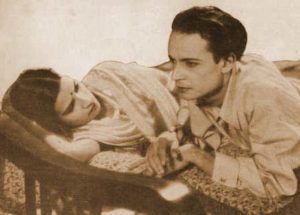 “Adhikar”, directed by P C Barua, was adjudged the Best Film of 1938 by the Film Journalists’ Association. The film was about parentage, pedigree and property and had a subtle, unintended message of the perils of transcending one’s social status and standing whether ascribed or achieved. With his unique style of storytelling and treatment, Barua disproves or invalidates the general belief that all rich are materialistic and mercenary and that all the poor are self effacing and submissive. Indeed, thought provoking!
“Adhikar”, directed by P C Barua, was adjudged the Best Film of 1938 by the Film Journalists’ Association. The film was about parentage, pedigree and property and had a subtle, unintended message of the perils of transcending one’s social status and standing whether ascribed or achieved. With his unique style of storytelling and treatment, Barua disproves or invalidates the general belief that all rich are materialistic and mercenary and that all the poor are self effacing and submissive. Indeed, thought provoking!
The film revolved around a ‘poor’ girl who is actually the illegitimate daughter of a rich man. On discovering that her father has bequeathed his property to his legitimate daughter, the poor girl sets out to avenge the wrong done to her and stake claim to her ‘rights’ (Adhikar) over the property. Through her immoral ways, she succeeds in dispossessing her rich half sister of her belongings including her beau. But she loses all the sympathy.
On one hand, Barua empathized with the compulsions of the destitute daughter and on the other hand, because of his own royal status, he identified with the dilemma of the robbed rich. He ends the film on an ambiguous note passing no moral judgement. The film was a moderate success.
“Dhartimata” as the title suggests was all about kheti and krishi, agriculture and farming. The film was directed by Nitin Bose and, like his other films, it was set in the socio-economic context and rural setting of cultivation and collective farming. K L Saigal and Jagdish Sethi played two friends brimming with two different ideas and ideologies about the progress of the country through collective farming and industrialization and technology respectively. While one responds to the call of the country, the other, to his callings.
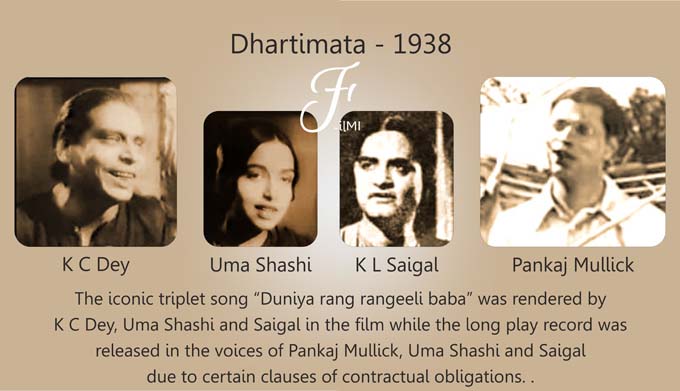
Music was by Pankaj Mullick and the film had the iconic triplet Duniya rang rangeeli baba sung by K C Dey, Uma Shashi and K L Saigal. In the long play disc, Mullick replaced Dey due to certain contractual obligations with the recording company. This was the first film song to use counter melody.
“Street Singer” marked the debut of Phani Mazumdar as a director in Hindi films. The film was about two young, ambitious singers who dream of making it big in the realm of music; quite predictably, they savour the taste of success but soon encounter the harsh realities of the glamour world. And, on realizing the values of a simple, want free life, they leave the city and get back to their roots. K L Saigal and Kanan Devi play the lead actors.

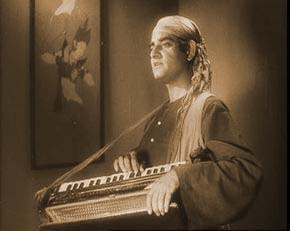 The film had great musical score by R C Boral and the film is much remembered for the Bhairavi based song Babul mora stylized as a thumri and sung by Saigal. The song has been rendered by several other singers ranging from Kesarbai Kerkar, Rasoolan Bai, Bade Ghulam Ali Khan, Bhimsen Joshi, Kishori Amonkar to Ajay Chakravarty, Padma Talwalkar, Jagjit Singh, Alisha Chinai …. but the elegy remains identified till date with the one and only K L Saigal under the baton of Boral!
The film had great musical score by R C Boral and the film is much remembered for the Bhairavi based song Babul mora stylized as a thumri and sung by Saigal. The song has been rendered by several other singers ranging from Kesarbai Kerkar, Rasoolan Bai, Bade Ghulam Ali Khan, Bhimsen Joshi, Kishori Amonkar to Ajay Chakravarty, Padma Talwalkar, Jagjit Singh, Alisha Chinai …. but the elegy remains identified till date with the one and only K L Saigal under the baton of Boral!
The original song was written by Wajid Ali Shah, the last Nawab of Awadh, when he was banished by the Britishers from Lucknow, the city he ruled passionately and ruined perfunctorily. Boral recreated the traditional Thumri in raag Bhairavi for the film “Street Singer”. And, the song with its metaphorical reference to the bidaai or farewell of a bride from her babul‘s (father) home remains an outstanding achievement of film music of the nascent 30s.
Bombay Talkies
Following the spectacular success of “Achhut Kanya” (1936) starring Ashok Kumar and Devika Rani, the two acted together in several other films. The year saw the coming together of the two in films like: “Nirmala” and “Vachan”. Both the films were directed by Franz Osten and had music by Saraswati Devi. With the same main and supporting cast, director, music director, other technicians, monotony started setting in and the films were not received with the same excitement and enthusiasm.
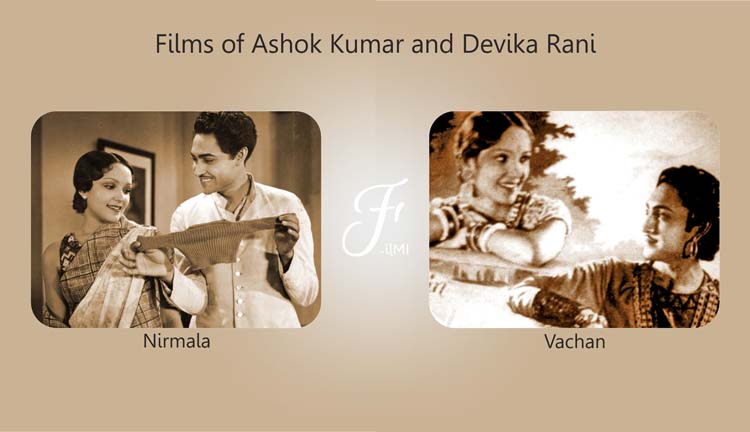
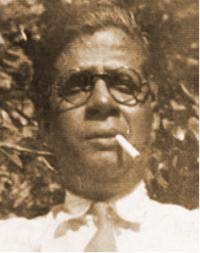 Niranjan Pal, screenplay writer and playwright, was a long time associate of Himanshu Rai from the time the latter made films like “The Light of Asia” and “Shiraz” in the 20s with German collaboration. Pal wrote the stories of these and other successful films made by Bombay Talkies like: “Jawani Ki Hawa”, “Jeevan Naiyya”, “Janmabhoomi”, “Achhut Kanya”. Following some creative differences with Rai, he left Bombay Talkies and Saradindu Bandyopadhyay took over and wrote films like “Nirmala” and “Vachan”.
Niranjan Pal, screenplay writer and playwright, was a long time associate of Himanshu Rai from the time the latter made films like “The Light of Asia” and “Shiraz” in the 20s with German collaboration. Pal wrote the stories of these and other successful films made by Bombay Talkies like: “Jawani Ki Hawa”, “Jeevan Naiyya”, “Janmabhoomi”, “Achhut Kanya”. Following some creative differences with Rai, he left Bombay Talkies and Saradindu Bandyopadhyay took over and wrote films like “Nirmala” and “Vachan”.
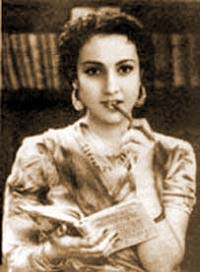 The other film from Bombay Talkies was “Bhabhi” starring Jairaj and Renuka Devi. The original name of Renuka Devi was Begum Khurshid Mirza who migrated to Pakistan after partition and acted in films and serials made there. She sang the Goud Malhar based Jhuki aayi re badariya sawan ki in the film “Bhabhi”. Incidentally, Roshan based his Garjat barsat beejat aayi lo (Malhar ~ 1951) and Garjat barsat sawan aayo re (Barsaat Ki Raat ~ 1960) on the same bandish in Goud Malhar.
The other film from Bombay Talkies was “Bhabhi” starring Jairaj and Renuka Devi. The original name of Renuka Devi was Begum Khurshid Mirza who migrated to Pakistan after partition and acted in films and serials made there. She sang the Goud Malhar based Jhuki aayi re badariya sawan ki in the film “Bhabhi”. Incidentally, Roshan based his Garjat barsat beejat aayi lo (Malhar ~ 1951) and Garjat barsat sawan aayo re (Barsaat Ki Raat ~ 1960) on the same bandish in Goud Malhar.
Sagar
Sagar had as many as six releases of different genre: “Dynamite”, Gramophone Singer”, “Hum Tum aur Woh”, “Postman”, “Three Hundred Days and After” and “Watan”. Of these, “Hum Tum aur Woh” and “Watan” were directed by Mehboob Khan, the blue eyed boy of Sagar and were successful.
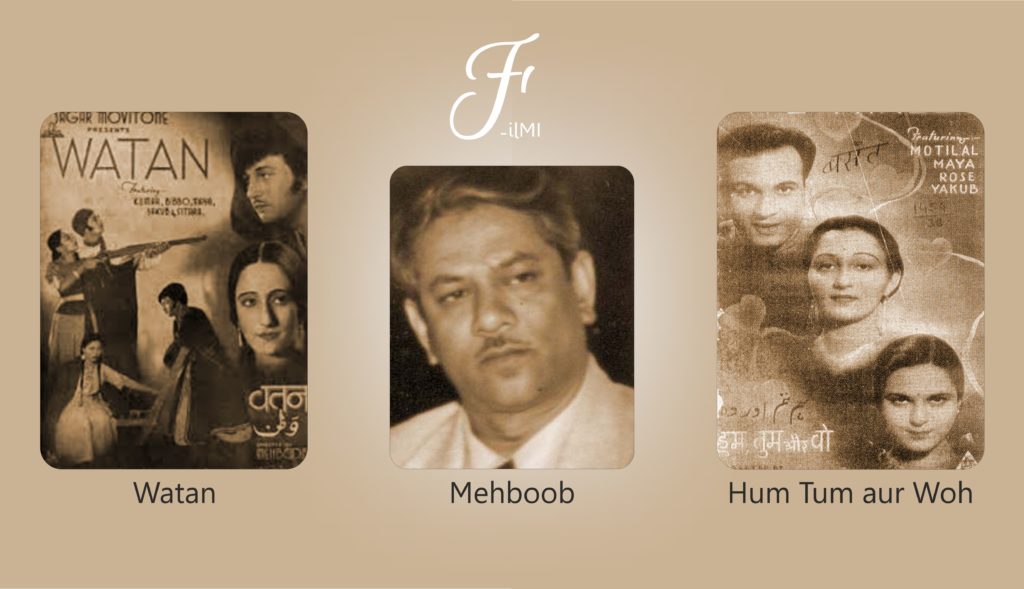
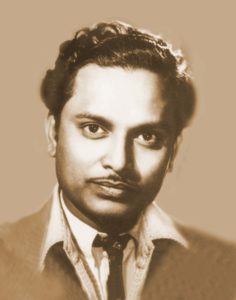 All the six films had music by Anil Biswas who had by then become a major musical force. One finds it difficult to associate the name of a thinking composer like Anil Biswas with films having ‘weird’ English titles. But, even in such films he gave music without discriminating and often prided in his compositions and the scope such films offered for experimentation and innovations.
All the six films had music by Anil Biswas who had by then become a major musical force. One finds it difficult to associate the name of a thinking composer like Anil Biswas with films having ‘weird’ English titles. But, even in such films he gave music without discriminating and often prided in his compositions and the scope such films offered for experimentation and innovations.
The film “300 Days and After” had an interesting story of a rich man (played by Motilal) who takes up a challenge with his doctor friend that he would go on a world tour without carrying any money and would survive for 300 days! Keeping in mind the character of Motilal and his limitations as a singer, Anil Biswas recorded two light hearted songs: Ghar apna ye kursi apni, apna sab samaan and Ik tum na hui to kya hua. In the same film, he recorded two semi classical based songs: Sundar hoon sakhi (in Khamaj) and Matt neer baha (in Bhairavi) in the voice of Bibbo.
Songs from these films are as remote as reality and as distant as dream. Not many of them became popular. They have been enumerated only to give a glimpse of his variety and versatility even in these ‘weird’ films. Relatively, the songs of “Gramophone Singer” were more popular viz. Kaahe akela dolat baadal and Ek chhota sa mandir banaayenge both in the voice of Surendra, the star singer of Sagar.
Prabhat
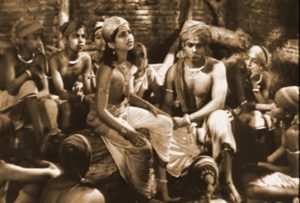 Prabhat had two releases: “Gopal Krishna” and “Mera Ladka”. “Gopal Krishna” was a talkie version of the studio’s silent film by the same name made in 1929. The film was directed by Damle and Fatehlal (partners of Shantaram) and had music by Master Krishnarao. The film starred Shanta Apte as Radha and Ram Marathe as Krishna.
Prabhat had two releases: “Gopal Krishna” and “Mera Ladka”. “Gopal Krishna” was a talkie version of the studio’s silent film by the same name made in 1929. The film was directed by Damle and Fatehlal (partners of Shantaram) and had music by Master Krishnarao. The film starred Shanta Apte as Radha and Ram Marathe as Krishna.
Characters in mythological films of that era like Krishna and his cowherds and the cruel king Kansa had allegorical references to the country men and the despotic British regime respectively.
Yet another partner of Prabhat, K Dhaiber directed a mythological film “Nanda Kumar” starring Govindrao Tembe and Durga Khote (the stars of Prabhat’s “Ayodhya Ka Raja”) and Anant Marathe. Incidentally, Ram Marathe and Anant Marathe were brothers and both played the role of Krishna in each of the two films. While “Gopal Krishna” was a success, “Nanda Kumar” was not.
Minerva
Sohrab Modi’s initial films like “Khoon Ka Khoon” (1935) and “Saeed-e-Hawas” (1936) were screen adaptations of Shakespeare’s plays Hamlet and King John respectively. Both the films were unsuccessful. And before he came to be acclaimed for his historical films, he made a couple of socials with a message like “Divorce” (or “Talaq”) and “Meetha Zahar”.
While “Divorce” dealt with rights of Hindu women to divorce and better divorce laws for women, “Meetha Zahar” highlighted the evils of alcohol. Both films starred his discovery Naseem (mother of Saira Banu).
Music in both the films was by Mir Sahab. Incidentally, C Ramchandra started his career as an assistant to Mir Sahab.
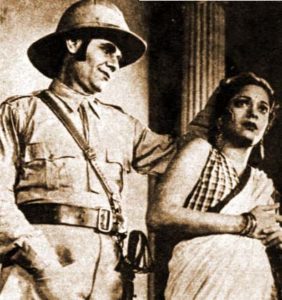 Yet another film from Minerva which evoked mixed reactions was “Jailor”. The film was based on the interrelation of social factors and individual behaviour. The film starred Modi as a kind hearted jailor and Leela Chitnis as his adulteress wife whose act of infidelity brings about a drastic transformation in him. From being kind and mild, he turns cold hearted and merciless and his misogynist attitude almost drives him to revel in sadistic indulgences. The psychodrama was a triumph for Modi both as an actor and director.
Yet another film from Minerva which evoked mixed reactions was “Jailor”. The film was based on the interrelation of social factors and individual behaviour. The film starred Modi as a kind hearted jailor and Leela Chitnis as his adulteress wife whose act of infidelity brings about a drastic transformation in him. From being kind and mild, he turns cold hearted and merciless and his misogynist attitude almost drives him to revel in sadistic indulgences. The psychodrama was a triumph for Modi both as an actor and director.
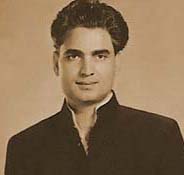 Before the film went on floors, an aspiring young writer named Syed Amir Hyder Kamal Naqvi met Modi with the hope of getting a break to write for his films. Modi looked at him from top to toe in a condescending manner and the young writer shot back immediately, “Modi sahab main koyi dekhne ki cheez nahin hoon, main sunne ki cheez hoon”. Modi was impressed with the man and his cutting rejoinder and Modi immediately signed the writer for his film. Sooner, Amir Hyder came to be known as the accomplished writer and director Kamal Amrohi. He wrote powerful dialogues for Modi’s first historical “Pukar” in the following year.
Before the film went on floors, an aspiring young writer named Syed Amir Hyder Kamal Naqvi met Modi with the hope of getting a break to write for his films. Modi looked at him from top to toe in a condescending manner and the young writer shot back immediately, “Modi sahab main koyi dekhne ki cheez nahin hoon, main sunne ki cheez hoon”. Modi was impressed with the man and his cutting rejoinder and Modi immediately signed the writer for his film. Sooner, Amir Hyder came to be known as the accomplished writer and director Kamal Amrohi. He wrote powerful dialogues for Modi’s first historical “Pukar” in the following year.
Incidentally, Modi made “Jailor” again in 1958 with himself, Geeta Bali, Kamini Kaushal and Abhi Bhattacharya. The film had immortal musical score by Madan Mohan.
Nostalgic Natter ~ 1938
The triumvirate of Sanjeev Kumar ~ Shashi Kapoor ~ Waheeda Rehman who went on to wield Yash Chopra’s “Trishul” forty years later in 1978 were born during the year.
Comedian actor ~ filmmaker Bhagwan made his debut as a director with “Bahadur Kisan” which had music by Mir Sahab. Rather, he co directed the film with one Chandrarao. While working with Mir Sahab, Bhagwan met his assistant C Ramchandra and the two became best friends. C Ramchandra later gave music for several B grade and stunt films of Bhagwan in the name of Anna Sahab or Ram Chitalkar and also for his biggest hit “Albela”.
Chaman Puri, brother of Madan Puri and Amrish Puri, made his debut as an actor with New Theatre’s “Abhaagin”.
Khan Mastana made his singing debut with “Bahadur Kisan”.
Zohrabai Ambalawali is believed to have made her singing debut in “Daku Ki Ladki” (1933) when she was barely 15 years. According to Anil Biswas, she made her singing debut in Sagar’s “Gramophone Singer”.
Naushad started his career as an assistant to music director Mushtaq Husain in the film “Industrial India”.
The iconic bidaai song Kaahe ko byaahi bides written by the multifaceted 13th century Persian poet Amir Khusro was first heard in Sohrab Modi’s “Jailor”.
In 1938, under the leadership of Chandulal Shah of Ranjit Movietone, the film industry celebrated the Silver Jubilee of Indian Cinema. Among the innumerable and illustrious guests seated was a man in his late sixties, totally unnoticed and unrecognized. He had sacrificed his life for films; he had made about a hundred silent films; he had a sprawling studio with all in-house facilities and which he ruled like a benevolent patriarch; the advent of sound and the changing times and trends affected his kind of films; he was a legend who was no more in the reckoning; he was relegated to the annals of history and had become forgotten name even when he was alive; he had lost everything that he owned and was reduced to penury; age and ailments had made him really unrecognisable!!
Who was this man who was literally sidelined and whose immense contribution to cinema was forgotten ruthlessly? Shantaram identified him and ushered him respectfully onto the stage and ‘introduced’ him to the then present movie moghals who owed every bit of their achievement and success to this man! That man was, hold your breath, none other than Dadasaheb Phalke, the Father of Indian Cinema who had single handedly and virtually shaped the future of Indian Cinema!!
The year 1938 will be remembered for this dishonourable and unforgivable act of discredit to the ‘Bhishma Pitama‘ of Indian Cinema if not for any other major cinematic contribution.
Top Twelve Popular Songs of 1938
| Name of Film | Song | Singer/s |
| Bhabhi | Jhuki aayi re badariya | Renuka Devi |
| Dhartimata | Duniya rang rangeeli baba | K C Dey-Uma Shashi-K L Saigal |
| Dhartimata | Main mann ki baat bataaun | K L Saiga-Uma Shashi |
| Gramophone Singer | Ek chhota sa mandir banaayenge | Surendra |
| Gramophone Singer | Kaahe akela dolat baadal | Surendra |
| Street Singer | Babul mora | K L Saigal |
| Street Singer | Jeevan been madhur na baaje | K L Saigal |
| Street Singer | Lachhmi moorat daras dikhaaye | Kanan Devi |
| Street Singer | Preetam se preet nibhaungi | Kanan Devi |
| Street Singer | Sanwariya prem ki bansi bajaaye | K L Saigal-Kanan Devi |
| Watan | Kyon humne diya dil | Sitara Devi |
| Watan | Hum dil mein soz-e-ishq ko | Sitara Devi |


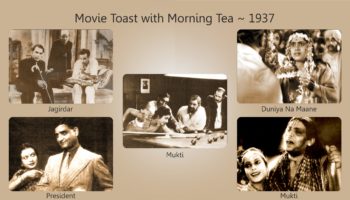
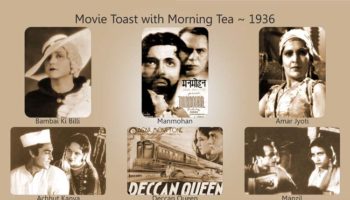
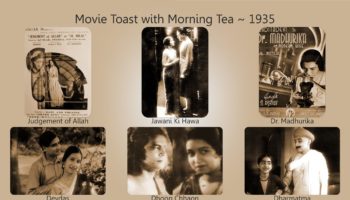
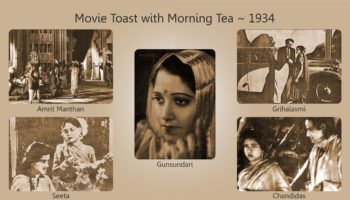

Dear Manohar,
Very informative article.s of 1937 & 1938. I had kept it for later reading in details, which I did today.
Thanks for spreading the knowledge of Indian Film History of which I am a keen learner..
Regards.. Suresh Tanwar
Thank you very much Suresh ji. Am glad such write ups find good readers like which is very encouraging.